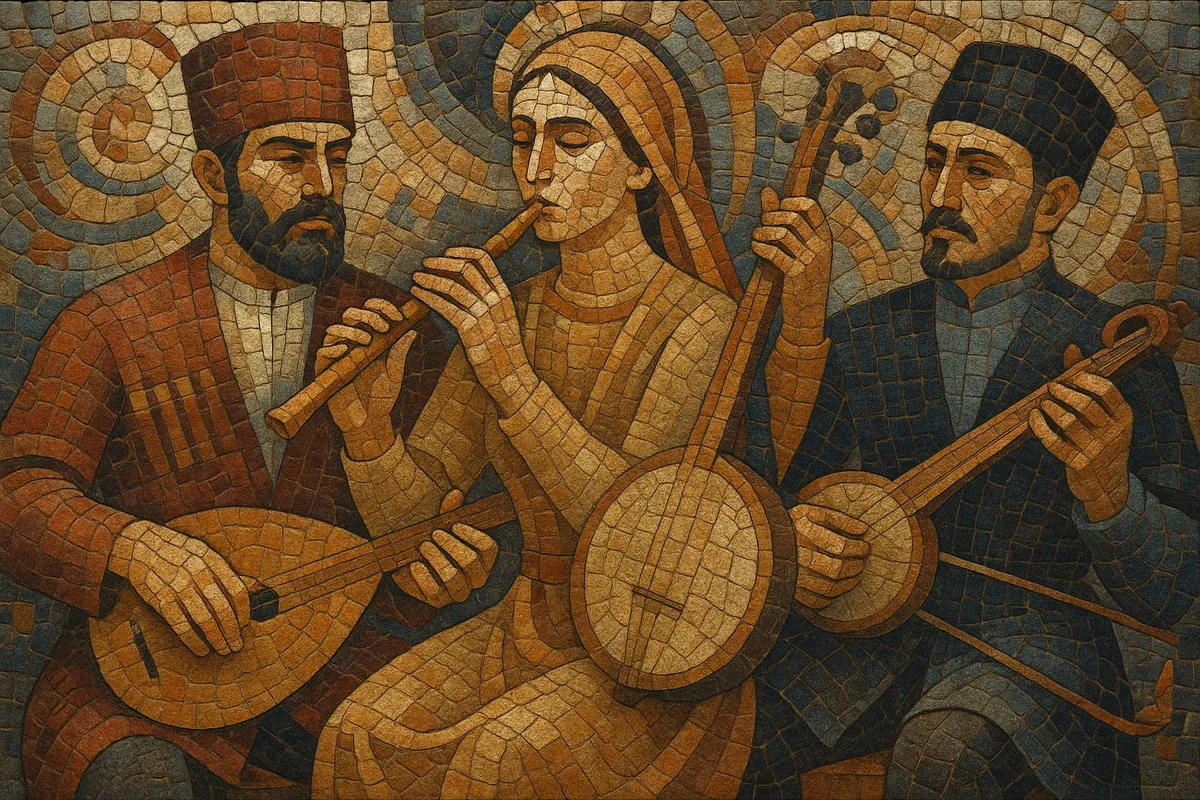Caucasian folk music encompasses the traditional vocal and instrumental practices of the South and North Caucasus, especially Georgia, Armenia, Azerbaijan, and the North Caucasian republics. It is characterized by striking vocal techniques (from Georgian multipart polyphony to highly ornamented bardic song), modal melodies, and asymmetrical “aksak” meters.
Hallmarks include robust drone-based polyphony and parallel fourths/fifths in Georgian song; the plaintive timbre of the Armenian duduk; the modal, melismatic art of ashugh/ashiq bards; and exuberant dance tunes like the pan-Caucasian lezginka. Common instruments include duduk/balaban and zurna (double reeds), salamuri (flute), tulum (bagpipe), panduri and chonguri (Georgian lutes), saz and tar (long- and short-necked lutes), kamancha (spike fiddle), garmon (button accordion), and doli/nagara (frame and kettle drums).
Themes often evoke mountains, hospitality, heroism, love, exile, and epic memory. The music’s blend of polyphony, maqam/makam-derived modality, and complex rhythms (5/8, 7/8, 9/8, 10/8) gives it a dramatic, communal, and highly kinetic character—equally at home in intimate gatherings and staged ensembles.
Folk practices in the Caucasus predate written records, developing in mountain communities where ritual, work songs, and dances marked seasonal cycles and social life. Two pillars emerged early: multipart choral traditions (especially in Georgia) and bardic song (ashugh/ashiq) spanning Armenia and Azerbaijan, both drawing on local languages, poetry, and communal performance.
From the medieval era, Christian liturgical chant (notably Georgian polyphonic chant influenced by Byzantine practice) and courtly/urban bardic cultures shaped folk idioms. Trade routes connected the region to Anatolia, Iran, and the Arab world, infusing modal concepts (maqam/makam), instruments (saz, kamancha, tar), and ornamental styles into village repertoires while local dance-rhythm vocabularies (aksak meters) remained distinct.
Romantic nationalism and ethnography in the Russian and Ottoman spheres spurred collection and arrangement of folk songs. Village repertories were notated, instruments standardized, and choral/dance ensembles formed, fixing iconic genres like lezginka and regional song types (Kartli-Kakheti, Guria, Svaneti; ashugh repertoires linked to Sayat-Nova and later masters).
State ensembles (song, dance, and instrumental) professionalized folk arts from the 1930s onward—e.g., Rustavi (Georgia), Shoghaken-linked circles in Armenia, and Lezginka (Dagestan). Radio, vinyl, and film spread Caucasian sounds across the USSR, while conservatories trained performers and codified polyphonic and modal pedagogy.
After independence, community ensembles, fieldwork, and festivals revived local styles. International interest in Georgian polyphony (UNESCO recognition), Armenian duduk, and Azeri bardic/mugham-influenced song brought the music to world stages. Contemporary artists blend village polyphony, ashugh poetics, and traditional dance rhythms with acoustic fidelity or tasteful fusion, sustaining a living tradition.


